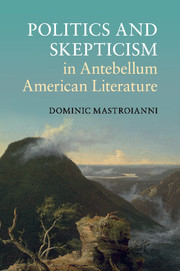Book contents
- Frontmatter
- Contents
- Acknowledgments
- Introduction: secret springs
- Chapter 1 Moods and the secret cause of revolution in Emerson
- Chapter 2 Revolutionary time and democracy’s causes in Melville’s Pierre
- Chapter 3 Hawthorne and the temperatures of secrecy
- Chapter 4 Causes of falling, Civil War, and the poetics of survival in Dickinson’s Fascicle 24
- Conclusion: antislavery writing, skepticism, and scorching words
- Notes
- Index
Chapter 2 - Revolutionary time and democracy’s causes in Melville’s Pierre
Published online by Cambridge University Press: 05 November 2014
- Frontmatter
- Contents
- Acknowledgments
- Introduction: secret springs
- Chapter 1 Moods and the secret cause of revolution in Emerson
- Chapter 2 Revolutionary time and democracy’s causes in Melville’s Pierre
- Chapter 3 Hawthorne and the temperatures of secrecy
- Chapter 4 Causes of falling, Civil War, and the poetics of survival in Dickinson’s Fascicle 24
- Conclusion: antislavery writing, skepticism, and scorching words
- Notes
- Index
Summary
In March and April of 1848, members of the U.S. Congress engaged in an intense debate over a resolution congratulating France on its recent revolution. Punctuated by heated arguments about slavery, the debate was colored by the same “preoccupation with permanence and stability” that Hannah Arendt finds “running like a red thread through the [U.S.] constitutional debates.” For example, Representative Henry W. Hilliard of Alabama worried that the revolution would not result in any “permanent good” for France. Hilliard’s argument for deferring congratulations stressed the difficulty of determining the final outcome of a revolutionary event: “The convulsion which exhibits a form so attractive to-day, may yet upturn the foundations of society, and result in the wildest anarchy.” While Representative John D. Cummins of Ohio urged against delaying congratulations, he asserted that if France should deviate from the model of the United States by consolidating all legislative power in a central body, it would thereby form “a government whose construction was incompatible with permanency – a government which could not exist.” For Cummins, the very existence of a government depended on the possibility of its enduring permanently. A real democracy, Cummins suggested, has to be constituted in a way that precludes the possibility of further revolutionary upheavals. Cummins implied that Hilliard’s uncertainty concerning the final results of revolutions could be resolved by founding the right form of government: a government that terminates the force of a revolutionary event.
- Type
- Chapter
- Information
- Publisher: Cambridge University PressPrint publication year: 2014



